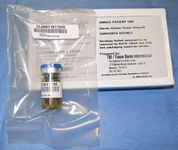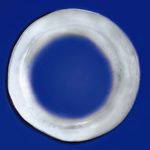Article
Cornea allograft provides alternative
A sterile cornea allograft has many advantages that make it a useful alternative to traditional eye bank corneas and other allograft material for a variety of graft procedures where viable endothelium is not needed.

The tissue is aseptically prepared at The National Eye Bank Center, Memphis, TN, using gamma-irradiation in a process that reduces the risk of bacterial, viral, and fungal disease transmission. The sterile cornea maintains excellent clarity, may be stored at room temperature for at least 1 year, and is available in various shapes, sizes, and thicknesses or can be custom cut to meet individual needs.

"The safety, convenience, and handling characteristics of sterile cornea make it very patient- and surgeon-friendly, and because of its long shelf-life, hospitals and other facilities find it feasible to keep this material on hand for emergency surgical needs," said Gerald Cole, president and chief executive officer, TBI, a non-profit organization of eye and tissue banks. There also are advantages for expanding the donor pool, he added.

TBI provided its first sterile cornea for clinical use in April 2009 and about 1 year later, distributed almost 400 allografts. The material was initially available only in the United States but will become available internationally soon.
Supportive findings

Surgeons were asked to rate a variety of parameters relating to intraoperative use and outcomes using a scale of 0 to 4, where scores in the range of 0 to 1 were considered "fair" and those ranging from 3 to 4 as "very good." Overall, the material received very high marks for tissue packaging, ease of use, tissue clarity, thickness, tensile strength, and ease of suturing (means all >3.6).
"In contrast to corneas that are stored in glycerin, cryopreserved, or lyophilized, use of the sterile cornea tissue requires minimal surgeon preparation," Cole said. "Because it is sterile, the package can be opened in the surgical field without compromising aseptic technique, and after a brief thorough rinsing, the allograft is ready to use."
Mean scores for postoperative outcomes, which included epithelialization, biological incorporation, and clarity, also were favorable (all ~3.4). Surgeons participating in the survey reported no problems with postoperative infection and no rejections.
"The clarity of the material provides good cosmetic results and is a big advantage for enabling functional assessment of glaucoma tube shunts or visualizing sutures around the drainage implants," Dr. Stark added.
Drawing on expertise
TBI has been sterile-processing other cadaveric tissue, including sclera, pericardium, and tissue for musculoskeletal and soft tissue graft procedures for decades. The idea of applying that capability to corneal tissue emerged about 2 years ago, according to Cole.
"The logistics for cornea were a little more challenging because of the need to maintain tissue clarity, but we were able to perfect our process and have a patent pending," he said.
In theory, considering the processing technique, the sterile cornea should remain viable indefinitely. Although TBI initially established a 1-year shelf-life, testing is now under way that would support extending the shelf-life to 2 years.

FYI
Walter J. Stark, MD
E-mail: wstark@jhmi.edu
Gerald Cole
E-mail: jcole@tbionline.org
Neither Dr. Stark nor Cole has a direct financial interest in the sterile cornea.





